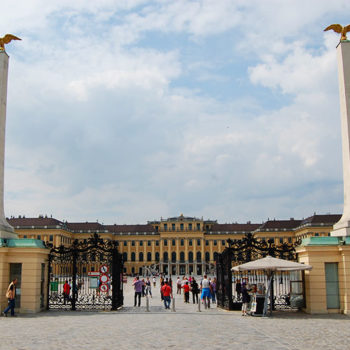Schönbrunn Palace has been a popular tourist attraction since the 18th century and UNESCO world heritage since 1996. The lavish imperial palace, with its magnificent gardens, is a must for any visitor to Austria’s capital Vienna.
Since I grew up in the Meidling district, where you find Schönbrunn Palace, I spent a lot of time as a child in the vast gardens of the imperial palace. As a four-year-old, I was relatively unaffected by the fact that I was playing in the garden of the mighty Habsburg dynasty, which ruled Austria for more than 600 years. More important to me was the size of the place and all the cool places to play hide and seek with my mother. Furthermore, the zoo (Schönbrunn Tiergarten) was as exotic as it could get for a city boy from Vienna.
Public Park since 1779
I have visited the 1,2 km2 large park numerous times and been inside the palace a few times. Nevertheless, the sheer scale, beauty, and fantastic architecture never cease to amaze me. Nor anyone else, for that matter. The Schönbrunn Palace receives around 8 million visitors annually and is the most visited landmark in Austria. During the summer months (June-August), large hordes of tourists rush out of coaches, cars, and the metro in their thousands, invading the palace. Hence, if you want to avoid crowds, arrive early on a weekday. Nevertheless, the park is vast, and you can find a quiet place even at the busiest times. Try Lange Wiese, near the Palmenhaus, for contemplation and to enjoy the park’s beauty relatively undisturbed.
< Click on the images to enlarge >
1441 rooms
Since its humble origins as a hunting lodge in 1638, Schönbrunn Palace was extensively rebuilt and expanded over the centuries. It got its present size, layout, and appearance in the middle of the 18th century. Although the palace only was the imperial family’s summer residence, it has a bountiful 1441 rooms. If the exterior impresses you, wait until you get inside the palace. The interior decorations are beyond your wildest dreams. No expense was spared in making some of the most lavishly decorated and stunning rooms I have ever seen. However, over time Schönbrunn Palace became more than a summer residence. It was one of Austria’s principal state residences where countless festivities and official events took place. Receiving an invitation to Schönbrunn was the highest honour for any domestic or foreign dignitary.
Popular all year
The museum and the parts of the palace open to the public gives you a small insight into the lavish lifestyle of one of the most powerful royal families in Europe, from the middle ages until the First World War. The museum itself receives around 3 million visitors per year and is a popular spectacle all year. I, therefore, recommend visiting the palace outside the main season, if you have the opportunity to do this. Springtime in Vienna (April and May) are often mild, and the newly blooming gardens are spectacularly colourful, making it a great time to visit. September still has the warm and lush feeling to it, making early autumn a good time to visit as well. Besides, the number of tourists has also diminished slightly.
ADVERTISEMENT
Coffee and cake
Do not forget to make your way up to the Gloriette. Constructed in 1775, it was used as a breakfast room and dining hall by the emperor and his entourage. The magnificent pavilion offers great views of Schönbrunn Palace, the gardens, and parts of Vienna. In addition to the rooftop viewing terrace, the Gloriette also houses a café. Why not join the Viennese for their favourite afternoon pastime, coffee and cake! I love spending a few hours at Schönbrunn. Leisurely strolling along some of the pathways or just enjoying a coffee and the views, before I get back to the hustle and bustle of the big city.
















